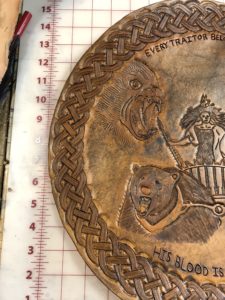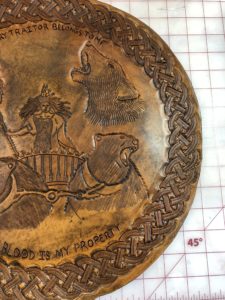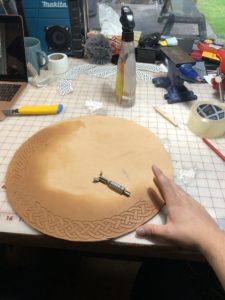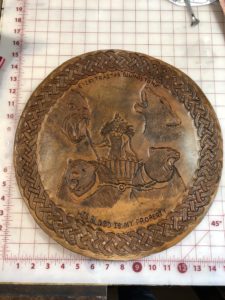




I decided to do my artistic representation on Jadis, the witch queen in the Lion the Witch and the Wardrobe novel. I felt Jadis to be a very interesting witch portrayal as the main antagonist in the book. The author, C.S. Lewis, integrated his Christian beliefs into his writing and unsurprisingly, Lewis used this witch character to embody all evil, and contextually plays the role of Satan in the underlying metaphor. I chose this not only because I loved the books growing up, but also because of its simplicity in representation. The book was written for younger children and is used as an allegory for the death and resurrection of Jesus who is represented in the form a huge lion named Aslan. The fact that a “great golden lion” is used as a form for Jesus and a witch is used as the Devil is fairly profound, because it describes how fundamentally evil a witch portrayal can still be revitalized in modern religious representations.
The Lion the Witch and the Wardrobe is about four younger children who find themselves in a fantasy land where they go on adventures and help the “good” creatures of the forest, and rid themselves of an evil ruling witch queen (Jadis) who has the power to make it always winter. Throughout the book, Jadis is hunting the children in an attempt to kill them. In the end, the witch queen is killed by the lion Aslan and peace is restored to the fantasy land. Jadis has several witch-like powers with the most obvious being her magic wand which she uses to turn creatures to stone. She is also able to control the weather, turn snow into objects like food or drinks, and sacrifices Aslan (the Jesus portrayal) in a sabbat like ritual surrounded by evil creatures. Jadis has several characteristic witch-like attributes like her callous/evil nature, her manipulative personality and her desire to kill the protagonist children and dominate basically everyone in the book.
I chose to do my representation using leatherwork, mostly because I thought it would portray a witch more adequately in a “primal tone”, but I also enjoy it and had a lot of time on my hands. I felt as though using leather gives the representation a pagan theme and would enhance the ritualistic feel of witches in general. I decided to dye the leather a deep reddish-black to make the image more grotesque in comparison to the original light brown colour of the original leather. By doing so I feel as though I made the representation both simplistic and complex in its meaning and portrayal.
I tried to make my representation as straightforward as possible so as to not misrepresent or confuse my projects witch queen character. I began by encircling the perimeter of a circular leather cut out with Celtic knots, which I thought would not only be aesthetically pleasing but also give it a more inherent pagan quality. I suppose these knots could also be used to represent the rope that the witch uses to tie up Aslan in the book, however, this may be too abstract. For Jadis herself, I used an image of her on a chariot pulled by two polar bears with the wand in her right hand and an (attempted) grim expression on her face. I used this portrayal from the cover of the 2005 Narnia movie[i], and even though this scene is never explicitly described in the books I thought it was an accurate representation of the witches’ authoritative and evil presence. On the right and left sides of the witch, I carved two wolves who in the book are loyal evil creatures that do the witches bidding (sadly the one on the left looks more like a gorilla). Along the top and bottom I wrote “Every traitor belongs to me” and “His blood is my property”. These are both quotations of the witch from the book, where she describes her natural right to dominate anyone who does wrong, in the case of the book this is one of the children who entered the Narnia world[ii]. This is a basis of my witch representation because when she says these words, she references a “deep magic” created by the “Emperor” (God) to lay claim to a child who betrayed his friends, with the intent to kill him.
After reading several segments from Hans Broedel’s book The Malleus Maleficarum and the Construction of Witchcraft I chose to include the writing above and below my representation that says “Every traitor belongs to me. His blood is my property”. In his book Broedel mentions that magic was “…a scourge afflicting those who had not yet embraced Christianity, later writers viewed magical harm instead in more general terms as a punishment for sinners.”[iii] This context fits fairly well with the book, as Jadis intends to kill a child who had done an evil act in betraying his friends, and the witch demands that by natural order she has the right to punish him. This quotation from Jadis in the depiction can also be related to Heinrich Kramer’s The Malleus Maleficarum, where Kramer mentions several times how the power of witchcraft is brought about by the permission from God[iv], which is similar to Jadis demanding her right given to her from “The Emperor” who is essentially Narnia’s God. After reading Wolves, Witches and Werewolves by Jane Davidson and Bob Canino I decided it fairly prudent to incorporate the witch with two wolves in the background. Davidson and Canino address several primary sources from 1432-1700 in their article, with most of them describing the witches’ believed ability to transfigure into wolves, summon wolves to do their bidding or in some instances ride them[v].
Broedel, Hans Peter. 2003;2004;. The Malleus Maleficarum and the Construction of Witchcraft: Theology and Popular Belief. Manchester: Manchester University Press.
Davidson, Jane P., and Bob Canino. “Wolves, Witches, and Werewolves: Lycanthropy and Witchcraft from 1423 to 1700.” Journal of the Fantastic in the Arts 2, no. 4 (8) (1990): 47-73. www.jstor.org/stable/43308065.
Kramer, Heinrich. “Malleus Maleficarum 1486” Witchcraft Sourcebook. 2003. Milton: Taylor & Francis Group. Accessed May 15, 2020. ProQuest Ebook Central.
Lewis, C. S., and Pauline Baynes. 1994. The Lion, the witch, and the wardrobe. New York, NY: HarperTrophy.
The Chronicles of Narnia. The Lion, the Witch and the Wardrobe. Burbank, CA : Walt Disney Home Entertainment, 2006.
[i] The Chronicles of Narnia. The Lion, the Witch and the Wardrobe. Burbank, CA : Walt Disney Home Entertainment, 2006.
[ii] Lewis, C. S., and Pauline Baynes. 1994. The Lion, the witch, and the wardrobe. New York, NY: HarperTrophy.
[iii] Broedel, Hans Peter. 2003;2004;. The Malleus Maleficarum and the Construction of Witchcraft: Theology and Popular Belief. Manchester: Manchester University Press: 76
[iv] Kramer, Heinrich. “Malleus Maleficarum 1486” Witchcraft Sourcebook. 2003. Milton: Taylor & Francis Group. Accessed May 15, 2020. ProQuest Ebook Central.
[v] Davidson, Jane P., and Bob Canino. “Wolves, Witches, and Werewolves: Lycanthropy and Witchcraft from 1423 to 1700.” Journal of the Fantastic in the Arts 2, no. 4 (8) (1990): 47-73. www.jstor.org/stable/43308065.
Writing Details
- Samuel Reeves
- June 10, 2020
- 1367
 This work by Samuel Reeves is licensed under a Creative Commons CC-BY Attribution 4.0 International License.
This work by Samuel Reeves is licensed under a Creative Commons CC-BY Attribution 4.0 International License.- Own Image
- Tweet
